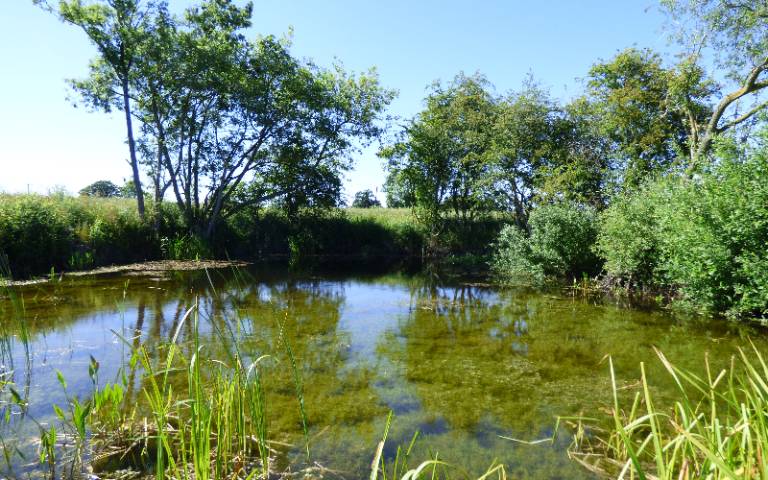How to bring ‘ghost ponds’ back from the dead
30 October 2023
Digging new ponds and resurrecting old “ghost ponds” can be done by landowners to revitalise biodiversity in natural and farmland landscapes, say UCL researchers in a new how-to guide for turning degraded ponds into thriving ecosystems.

The manual, developed by the UCL Pond Restoration Research Group in conjunction with Freshwater Habitats Trust and Norfolk Ponds Project, is designed to help landowners, farmers and other stewards of the land to manage existing ponds, restore degraded ponds and determine the best ways to create new ones. The report highlights research showing that increasing the number of clean water ponds in a region can boost freshwater biodiversity and protect against future species decline.
The team timed the release of the report to coincide with a Norfolk Ponds Project week to restore a number of ponds on a mid Norfolk farm. Since its creation in 2014, Norfolk Ponds Project, in collaboration with UCL researchers, has restored more than 250 ponds reviving aquatic flora and fauna across the farmed landscape.
The guide highlights techniques for identifying sites to locate new ponds, ways to resurrect long-lost and filled in “ghost ponds” and methods for clearing excess scrub and accumulated organic material from old ponds (so-called “zombie ponds”) invaded by trees and scrub, as well as how to identify the kinds of wildlife that indicate whether a pond is healthy or in need of attention.
Lead author Professor Carl Sayer (UCL Geography) said: “We hope that this new guide will become a valuable resource for all who are interested in protecting freshwater in the environment and restoring some of the UK’s lost biodiversity. Having lots of healthy ponds in the landscape is vital to the health of our countryside.”
The UK is one of the most nature-depleted countries in the world, and the loss of old and ancient ponds is a symptom of this degradation. Ponds were once widespread natural habitat throughout the UK, but their prevalence has declined over the past century. Roughly two thirds of ponds in England and Wales present in the late 19th century have been lost, primarily through drainage and infilling for agricultural land reclamation. Many surviving ponds have been damaged by pollution and by being overwhelmed by invading scrub and trees.
There are many different types of ponds which are home to numerous species of plant and animal, but common characteristics of healthy ponds include clean water, diverse native plant life and surroundings dominated by natural vegetation so that there is a buffer between a pond and farmed land.
Thriving ponds offer numerous benefits to wildlife and the natural environment. They act as biodiversity refuges for potentially endangered species of aquatic invertebrates, plants, amphibians and fishes, such as the crucian carp. In addition, they serve as vital habitats and as a source of food and water for other wildlife, including pollinators, nesting birds and mammals of all sizes.
The researchers emphasise in their guide that “multipurpose” ponds usually only bring limited benefits to wildlife, and that ponds should be set aside for wildlife and not be used for other purposes such as pollution interception, drainage, irrigation, flood management or commercial duck shooting.
The report emphasises the relative ease with which ponds can be brought to life. Digging out new ponds and rehabilitating ghost ponds and tree-shaded ponds can often be done over the course of one or two days using a small excavator, and in a short time, often in less than two years, thriving ecosystems result.
Report co-author Helen Greaves (UCL Geography and Norfolk Ponds Project Strategic Lead) said: “Freshwater habitats cover only about 2% of the Earth's surface, but have the highest animal species richness per area. When a healthy pond sits in the farmland landscape, the two land uses can exist side by side and even reinforce each other. By acting as a home for pollinators and as food sources for birds and bats, a symbiotic relationship exists between a healthy pond and the surrounding agricultural land leading to nature recovery that benefits all.”
The report was co-authored with Freshwater Habitats Trust, with funding provided by UCL and much encouragement and support from Natural England.
Links
- Read: ‘Guide to the Restoration, Creation and Management of Ponds: Bringing ponds to life’
- Norfolk Ponds Project website
- Freshwater Habitats Trust
- Professor Carl Sayer's academic profile
- UCL Department of Geography
- Faculty of Social & Historical Sciences
Image
- A restored pond in Norfolk. Credit: Professor Carl Sayer
Media Contact
Mike Lucibella
- E: m.lucibella [at] ucl.ac.uk
 Close
Close

